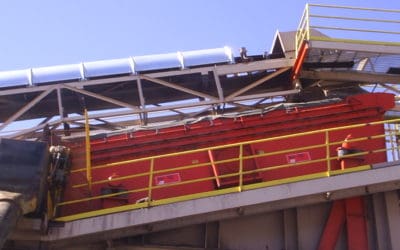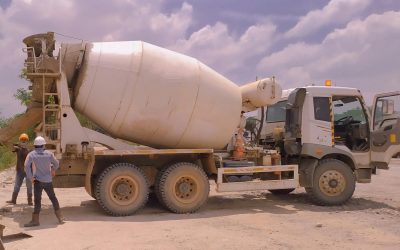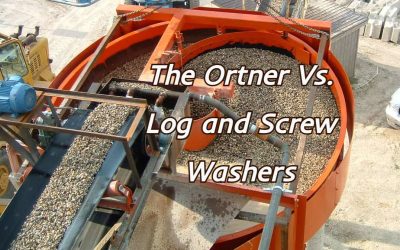Aggregate screening is a foundational process in construction and material processing — mechanically sorting crushed stone, sand, and gravel into precise size fractions. This ensures consistent quality and compliance with engineering specifications, making the materials saleable and safe for infrastructure use. When executed effectively, screening improves product consistency, protects crushers from excessive wear, lowers maintenance costs, and enhances sustainability by minimizing waste and maximizing usable output.
In this article, we’ll explore the fundamentals of the screening process. We’ll explain how it works, dive into the various types of screening equipment, and outline the benefits in various industries.
What are Aggregates?
Aggregates are hard, granular materials — such as sand, gravel, crushed stone, slag, or recycled concrete — used extensively in the construction industry. They are combined with binders (like cement or bitumen) to create composite materials, such as concrete and asphalt, providing structural strength, stability, and volume to roads, foundations, and buildings.
Often sourced from natural pits and quarries, aggregates are globally the most-used mined materials, playing a foundational role in infrastructure development.
How Does Screening Work?
- Feeding and agitation: Materials are loaded onto one or more screen decks, and the screen vibrates to agitate the feed, moving particles forward while promoting size-based separation.
- Stratification: Vibration causes larger particles to rise toward the top while finer particles sink toward the surface, bringing them closer to screen openings.
- Crowded screening: As material moves across the screen, fine particles begin passing through the mesh openings together.
- Separated screening: In this final sorting stage, near-sized particles get their last opportunity to pass through the mesh openings. Remaining fines exit the screen as the screen moves the remaining coarse particles off the deck.
- Material conveyance and discharge: Gravity and screen motion work together to transport materials across the deck. Larger particles travel to discharge points while finer materials fall through mesh openings. Multiple decks in a unit help produce several size-grade outputs.
The Main Types of Aggregate Screens
Grizzly (Scalping) Screens
These rugged, static bar-style screens are typically used as the first stage in mining and quarry operations. Grizzly screens remove oversized rocks before crushing, protecting downstream equipment and boosting throughput. They’re built to handle large, abrasive material with minimal maintenance.
Vibrating Screens
These highly versatile screens use either inclined or horizontal motion to stratify and separate bulk materials:
Inclined screens are mounted at 5 to 45°, leveraging gravity and vibration for high-capacity sorting — making them ideal for coarse aggregates in quarries.
Horizontal screens sit flat or slightly sloped and rely on powerful elliptical or linear motion. They retain material longer, offer precise size separation, and are ideal for fine aggregates or space-restricted sites. These screens often come in stacked multi-deck configurations, allowing multiple size grades to be separated in a single pass.
High-Frequency Vibrating Screens
Operating at 1,500 to 9,000 RPM with low stroke, these screens excel at fine-particle grading, such as manufactured sand or mineral fines. They create strong G-force stratification for highly efficient separation — but are prone to quicker wear and plugging in damp or sticky feeds.
Trommel (Rotary) Screens
These feature a rotating cylindrical drum with perforations. As the drum turns, smaller particles fall through, and larger material exits at the end. Trommel screens are excellent for screening topsoil or sticky/wet materials due to their gentle handling, though they use a smaller portion of the screen area and may require brushing to prevent clogs.
Industry Benefits
Mining and Aggregate Production
In mining and quarry operations, vibrating screens are essential for efficiently sorting core materials (like gravel, sand, and crushed stone) by size. This separation improves material quality, protects downstream equipment from damage, and boosts yield and processing consistency.
Construction and Road Building
Accurately screened aggregates are vital for achieving proper compaction and long-lasting roadway and surface integrity. Removing oversized or undersized particles helps prevent uneven settling, reduces maintenance needs, and enhances overall structural stability.
Recycling and Waste Management
Screens help process construction and demolition debris, soil, and municipal solid waste. Trommel and vibratory screens sort reusable materials — like clean aggregate — from waste, enabling recycling, reducing landfill use, and promoting circular economy practices.
Mineral Processing and Fine Particle Separation
High-frequency vibrating screens specialize in separating fine particles, making them ideal for fine mineral ores, manufactured sand, and asphalt recycling. Their precision improves material purity and extraction efficiency.
Sustainability and Operational Efficiency
Improved screening reduces waste and enables better reuse and recycling of materials — such as reclaimed concrete or demolition debris. Automation and advanced screening technologies further enhance sustainability, quality control, and cost savings in material processing.
How to Choose the Right Aggregate Screen
Selecting the best screen for your operation involves evaluating several critical factors to ensure maximum efficiency and durability:
- Material characteristics: Consider particle size distribution, moisture content, abrasiveness, shape, and density. For example, high-moisture, sticky materials require screen types that resist blinding.
- Screen type and motion: Inclined screens (5 to 45°) leverage gravity for energy-efficient processing. Horizontal screens (0 to 10°) provide longer retention time and precise separation — especially useful for fine or wet materials.
- Separator purpose and capacity: Your desired throughput (in TPH), required cut size, and intended application — whether for scalping, dewatering, or grading — should all guide screen selection.
- Screen media: Woven wire cloth offers high open-area and low cost but lower wear life. Rubber or polyurethane panels are more durable and ideal for abrasive or moist feeds but may reduce throughput slightly.
- Operational conditions: Account for feed rate, bed depth (optimal depth should not exceed approximately 4× the screen openings), vibration amplitude and frequency, deck inclination, and maintenance access points.
Once the above baseline has been considered, you may find that challenging materials — especially those prone to blinding or clogging — require a more-advanced screening approach. This is where BIVITEC® technology shines:
- Dual-vibration design: BIVITEC® employs dynamic tensioning and relaxing of flexible polyurethane mats using dual vibratory action, enabling incredibly high acceleration forces (material up to ~50g’s). This ensures consistent screen-clearing action against fine or sticky materials.
- Blinding elimination and high-throughput: Designed specifically for problematic or high-moisture feeds, the BIVITEC® delivers fine separation without clogging or accuracy loss — offering wider effective screening areas with rugged, low-maintenance performance.
If you have any questions about our aggregate screens, please feel free to reach out to us anytime.


